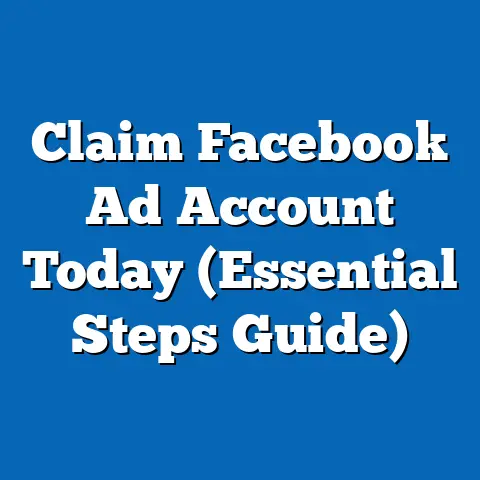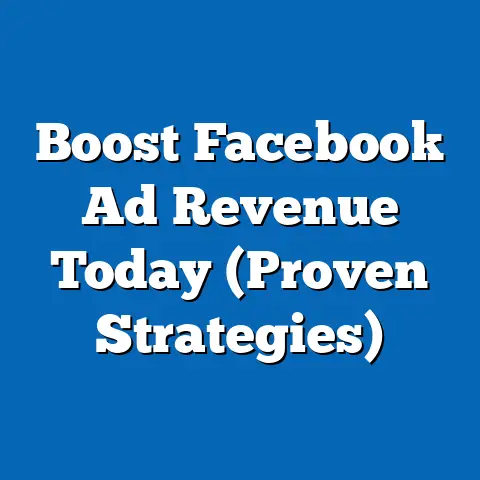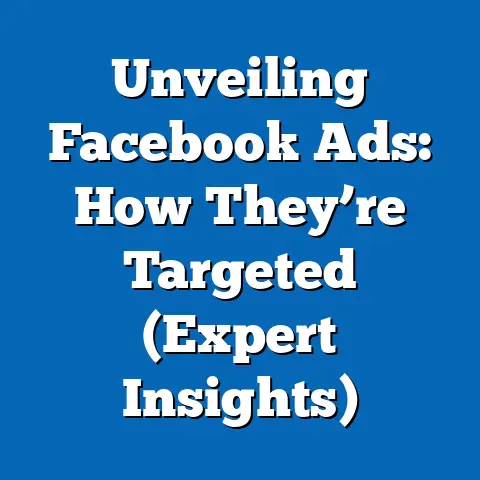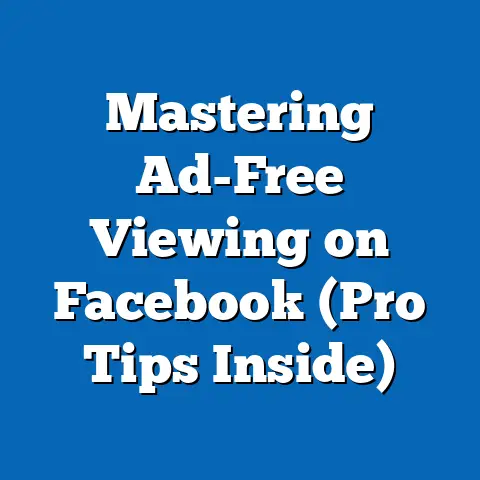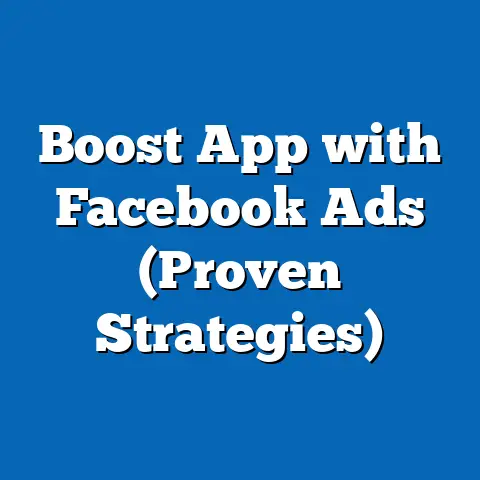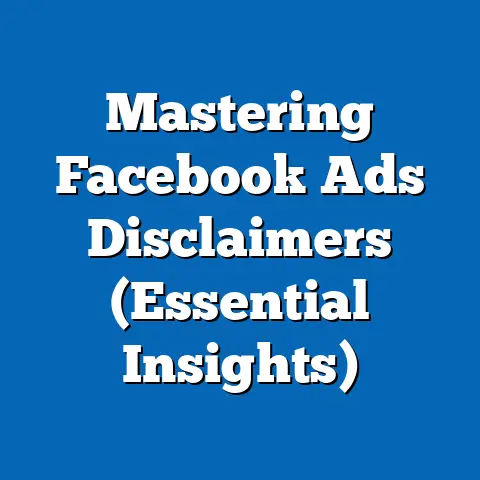Boost Open House Attendance (Proven fb ad Strategies)
As a digital marketing specialist with years of experience in the real estate industry, I’ve seen firsthand the transformative power of Facebook ads. In today’s competitive market, simply listing a property and hoping for a crowd at your open house is no longer enough. You need to be proactive, strategic, and targeted. That’s where Facebook ads come in. They’re an incredibly powerful tool for real estate agents and home sellers looking to dramatically increase attendance at open houses, leading to quicker sales and better offers.
Think about it: most potential homebuyers are already spending a significant amount of time on Facebook. By strategically placing your open house in their newsfeed, you’re meeting them where they are and capturing their attention with relevant, engaging content. But it’s not just about throwing money at Facebook and hoping for the best. It’s about understanding your audience, crafting compelling ad content, selecting the right ad format, and leveraging the platform’s unique features to maximize your reach and impact.
In this article, I’m going to walk you through proven Facebook advertising strategies specifically designed to enhance open house attendance. I’ll share my personal experiences, industry insights, and actionable tips that you can implement immediately to see real results. We’ll delve into everything from identifying your target audience to crafting killer ad copy, selecting the right ad format, setting a budget, and even leveraging Facebook Events. By the end of this guide, you’ll have a comprehensive understanding of how to use Facebook ads to transform your open houses from sparsely attended events to bustling hubs of potential buyers. Let’s get started!
Section 1: Understanding Your Audience
The cornerstone of any successful marketing campaign, and especially Facebook advertising, is a deep understanding of your target audience. You can have the most beautiful photos and the most captivating ad copy, but if you’re showing it to the wrong people, it’s all for naught. Think of it like this: you wouldn’t try to sell a luxury penthouse to a college student, would you? Similarly, you need to tailor your Facebook ads to reach the specific individuals who are most likely to be interested in your open house.
The Importance of Identifying Your Target Audience
Before you even think about creating an ad, take a step back and ask yourself: who are you trying to reach? Are you targeting first-time homebuyers? Empty nesters looking to downsize? Young families searching for a bigger home with a yard? Investors seeking rental properties? Each of these groups has different needs, wants, and motivations, and your ads need to speak directly to them.
For example, I once worked with a real estate agent who was struggling to attract attendees to an open house for a condo in a vibrant downtown area. Initially, they were targeting a broad audience, hoping to cast a wide net. However, after analyzing the property and the surrounding neighborhood, we realized that the ideal buyer was likely a young professional or a couple without children who enjoyed the urban lifestyle. We then narrowed our targeting to this specific demographic and saw a significant increase in attendance and qualified leads.
Demographic Targeting on Facebook
Facebook offers a wealth of demographic targeting options that allow you to laser-focus your ads on the right people. Here are some of the key factors to consider:
- Age: Are you targeting millennials, Gen X, or baby boomers?
- Income: What is the typical income range of potential buyers in your area?
- Location: Are you focusing on local residents or people who might be relocating from out of state?
- Interests: What are their hobbies, passions, and interests? Are they interested in home improvement, interior design, or gardening?
- Education: What is their level of education? Are they college graduates or professionals with advanced degrees?
- Life Events: Are they recently married, engaged, or have they recently had a baby?
By combining these demographic factors, you can create highly targeted audiences that are much more likely to be interested in your open house.
Creating Audience Personas
One of the most effective ways to understand your target audience is to create audience personas. A persona is a fictional representation of your ideal buyer, based on market research, buyer behavior, and local trends. Give them a name, a backstory, and a set of characteristics that represent their needs, wants, and motivations.
Here’s an example of an audience persona for a luxury home in a suburban area:
- Name: Sarah Johnson
- Age: 42
- Occupation: Executive at a tech company
- Income: $250,000 per year
- Family: Married with two children
- Interests: Travel, fine dining, golf, interior design
- Motivations: Looking for a spacious home with a large yard and a good school district for her children. Wants a home that reflects her success and provides a comfortable and luxurious lifestyle.
By creating this persona, you can start to understand Sarah’s needs and motivations. You can then tailor your ad content and targeting to appeal directly to her.
Examples of Demographic Targeting Strategies
Here are a few examples of how different demographics might respond to various ad strategies:
- First-Time Homebuyers: Target millennials and Gen Z with ads that emphasize affordability, convenience, and the benefits of homeownership. Use visuals that showcase modern design and features that appeal to younger buyers.
- Empty Nesters: Target baby boomers with ads that highlight the benefits of downsizing, such as lower maintenance costs, a more manageable living space, and the freedom to travel. Use visuals that showcase single-story homes, accessible features, and nearby amenities.
- Young Families: Target families with young children with ads that emphasize the importance of good schools, safe neighborhoods, and spacious homes with yards. Use visuals that showcase family-friendly features, such as playgrounds, parks, and community events.
- Investors: Target individuals with an interest in real estate investing with ads that highlight the potential for rental income, appreciation, and tax benefits. Use visuals that showcase properties with high rental yields and potential for future growth.
Key Takeaway: Understanding your target audience is the foundation of any successful Facebook advertising campaign. By identifying their needs, wants, and motivations, you can create highly targeted ads that resonate with them and drive attendance to your open houses.
Next Steps:
- Conduct market research to identify your target audience for each property.
- Create audience personas based on your research.
- Use Facebook’s demographic targeting options to create highly targeted audiences.
Section 2: Crafting Compelling Ad Content
Now that you know who you’re trying to reach, the next step is to create ad content that will grab their attention and entice them to attend your open house. This is where your creativity and marketing skills come into play. Remember, you’re competing with hundreds of other ads in their newsfeed, so your content needs to stand out.
Elements of Effective Facebook Ad Content
Effective Facebook ad content consists of three key elements:
- Eye-Catching Visuals: High-quality images and videos that showcase the property in its best light.
- Engaging Copy: Compelling text that highlights the unique selling points of the property and the benefits of attending the open house.
- Strong Calls-to-Action (CTAs): Clear and concise instructions that tell people what you want them to do, such as “Attend the Open House,” “RSVP Now,” or “Learn More.”
The Importance of High-Quality Visuals
In the world of Facebook advertising, visuals are king. People are naturally drawn to images and videos, so your visuals need to be attention-grabbing and visually appealing. Avoid using blurry or low-resolution images. Instead, invest in professional photography or videography that showcases the property’s best features.
Here are some tips for creating high-quality visuals:
- Use professional photography: Hire a professional photographer who specializes in real estate photography. They will know how to capture the property in its best light and highlight its unique features.
- Consider virtual tours: A virtual tour allows potential buyers to walk through the property from the comfort of their own home. This can be a great way to generate interest and encourage people to attend the open house.
- Use drone footage: Drone footage can provide a unique perspective of the property and its surroundings. This can be especially effective for properties with large lots or stunning views.
- Showcase the lifestyle: Don’t just show the property itself. Showcase the lifestyle that it offers. For example, if the property has a large backyard, show a family enjoying a barbecue. If it’s located in a vibrant downtown area, show people enjoying the local restaurants and shops.
I remember one instance where a real estate agent I was working with was hesitant to invest in professional photography. They thought the photos they took with their smartphone were good enough. However, after we convinced them to hire a professional photographer, the difference was night and day. The professional photos were brighter, more vibrant, and showcased the property in a much more appealing way. As a result, we saw a significant increase in engagement and attendance at the open house.
Writing Compelling Ad Copy
While visuals are important, your ad copy also plays a crucial role in convincing people to attend your open house. Your ad copy should be clear, concise, and engaging. It should highlight the unique selling points of the property and the benefits of attending the open house.
Here are some tips for writing compelling ad copy:
- Highlight the unique selling points: What makes this property special? Is it the location, the amenities, the design, or the price? Focus on the features that will appeal to your target audience.
- Emphasize the benefits of attending the open house: Why should people take the time to attend your open house? Will they have the opportunity to see the property in person, ask questions, and meet the real estate agent?
- Use a sense of urgency: Create a sense of urgency by mentioning that the open house is only for a limited time. This will encourage people to attend sooner rather than later.
- Use strong calls-to-action: Tell people what you want them to do. Use clear and concise CTAs such as “Attend the Open House,” “RSVP Now,” or “Learn More.”
Examples of Successful Ad Copy and Visuals
Here are a few examples of successful ad copy and visuals, with analysis of what makes them effective:
- Example 1:
- Visual: A stunning photo of the property’s living room with a fireplace and large windows.
- Copy: “Cozy up this winter in this beautiful home with a fireplace and stunning views. Attend our open house this Saturday from 1-4 PM. RSVP now!”
- Analysis: This ad uses a visually appealing photo and highlights the cozy atmosphere of the property. It also includes a clear CTA and a sense of urgency.
- Example 2:
- Visual: A video of a family enjoying a barbecue in the property’s backyard.
- Copy: “Imagine spending your summer evenings in this spacious backyard with a built-in barbecue. This family-friendly home is perfect for entertaining. Attend our open house this Sunday from 2-5 PM. Learn more!”
- Analysis: This ad showcases the lifestyle that the property offers and appeals to families with young children. It also includes a clear CTA and a link to learn more about the property.
- Example 3:
- Visual: A virtual tour of the property.
- Copy: “Take a virtual tour of this stunning home from the comfort of your own couch! Attend our open house this Saturday from 1-4 PM to see it in person. RSVP now!”
- Analysis: This ad offers a convenient way for potential buyers to preview the property and encourages them to attend the open house to see it in person. It also includes a clear CTA and a sense of urgency.
- Visual: A stunning photo of the property’s living room with a fireplace and large windows.
- Copy: “Cozy up this winter in this beautiful home with a fireplace and stunning views. Attend our open house this Saturday from 1-4 PM. RSVP now!”
- Analysis: This ad uses a visually appealing photo and highlights the cozy atmosphere of the property. It also includes a clear CTA and a sense of urgency.
- Visual: A video of a family enjoying a barbecue in the property’s backyard.
- Copy: “Imagine spending your summer evenings in this spacious backyard with a built-in barbecue. This family-friendly home is perfect for entertaining. Attend our open house this Sunday from 2-5 PM. Learn more!”
- Analysis: This ad showcases the lifestyle that the property offers and appeals to families with young children. It also includes a clear CTA and a link to learn more about the property.
- Visual: A virtual tour of the property.
- Copy: “Take a virtual tour of this stunning home from the comfort of your own couch! Attend our open house this Saturday from 1-4 PM to see it in person. RSVP now!”
- Analysis: This ad offers a convenient way for potential buyers to preview the property and encourages them to attend the open house to see it in person. It also includes a clear CTA and a sense of urgency.
Key Takeaway: Compelling ad content is essential for attracting attention and driving attendance to your open houses. Use high-quality visuals, engaging copy, and strong calls-to-action to create ads that resonate with your target audience.
Next Steps:
- Invest in professional photography or videography for your properties.
- Write compelling ad copy that highlights the unique selling points of the property and the benefits of attending the open house.
- Use strong calls-to-action to tell people what you want them to do.
Section 3: Selecting the Right Ad Format
Facebook offers a variety of ad formats that you can use to promote your open houses. Each format has its own advantages and disadvantages, and the right choice will depend on your goals, budget, and target audience.
Overview of Facebook Ad Formats
Here’s a brief overview of the most common Facebook ad formats:
- Single Image Ads: These ads consist of a single image and a block of text. They are simple to create and can be effective for showcasing a property’s best features.
- Single Video Ads: These ads consist of a single video and a block of text. They are more engaging than image ads and can be used to showcase the property in a more dynamic way.
- Carousel Ads: These ads consist of a series of images or videos that users can swipe through. They are ideal for showcasing multiple features of a property or telling a story.
- Slideshow Ads: These ads are similar to carousel ads, but they use a series of still images that are automatically displayed in a slideshow format. They are a cost-effective way to create engaging video-like content.
- Collection Ads: These ads are designed for e-commerce businesses, but they can also be used to showcase multiple properties in a single ad. They typically consist of a cover image or video and a series of product images.
- Lead Ads: These ads allow users to submit their contact information directly from the ad, without having to leave Facebook. They are a great way to generate leads for your real estate business.
- Event Ads: These ads are specifically designed to promote events, such as open houses. They include information about the event, such as the date, time, and location, and allow users to RSVP directly from the ad.
Advantages of Each Ad Format for Promoting Open Houses
Here’s a breakdown of the advantages of each ad format for promoting open houses:
- Single Image Ads: Simple to create, cost-effective, and effective for showcasing a property’s best features.
- Single Video Ads: More engaging than image ads, can showcase the property in a more dynamic way, and can be used to tell a story.
- Carousel Ads: Ideal for showcasing multiple features of a property or telling a story, and can be used to highlight different aspects of the property.
- Slideshow Ads: Cost-effective way to create engaging video-like content, and can be used to showcase a property’s features in a visually appealing way.
- Collection Ads: Can showcase multiple properties in a single ad, and are ideal for real estate agencies with a large portfolio of listings.
- Lead Ads: Great way to generate leads for your real estate business, and allow users to submit their contact information directly from the ad.
- Event Ads: Specifically designed to promote events, and include information about the event, such as the date, time, and location. Allow users to RSVP directly from the ad.
Choosing the Right Ad Format
The best ad format for promoting your open house will depend on your specific goals and budget. Here are some factors to consider:
- Your Budget: Some ad formats, such as video ads, can be more expensive to create than others, such as image ads.
- Your Goals: Are you trying to generate leads, drive traffic to your website, or simply increase awareness of your open house?
- Your Target Audience: What type of content does your target audience prefer? Do they prefer images, videos, or text?
For example, if you have a limited budget, you might want to start with single image ads or slideshow ads. If you’re trying to generate leads, lead ads might be a good option. And if you’re trying to promote a specific event, event ads are the way to go.
I’ve found that carousel ads are particularly effective for showcasing multiple features of a property. You can use each image or video in the carousel to highlight a different aspect of the property, such as the living room, the kitchen, the backyard, or the neighborhood. This allows potential buyers to get a more comprehensive view of the property and its amenities.
Optimizing Each Ad Format for Maximum Engagement and Attendance
No matter which ad format you choose, there are a few things you can do to optimize it for maximum engagement and attendance:
- Use High-Quality Visuals: As I mentioned earlier, visuals are key. Make sure your images and videos are high-resolution, well-lit, and visually appealing.
- Write Compelling Ad Copy: Your ad copy should be clear, concise, and engaging. Highlight the unique selling points of the property and the benefits of attending the open house.
- Use Strong Calls-to-Action: Tell people what you want them to do. Use clear and concise CTAs such as “Attend the Open House,” “RSVP Now,” or “Learn More.”
- Target the Right Audience: Make sure you’re targeting the right people. Use Facebook’s demographic targeting options to laser-focus your ads on your ideal buyers.
- Test Different Ad Formats and Targeting Options: Don’t be afraid to experiment with different ad formats and targeting options. Track your results and see what works best for your business.
Key Takeaway: Facebook offers a variety of ad formats that you can use to promote your open houses. Choose the right format based on your goals, budget, and target audience, and optimize it for maximum engagement and attendance.
Next Steps:
- Explore the different ad formats available on Facebook.
- Choose the right ad format based on your goals, budget, and target audience.
- Optimize your ads for maximum engagement and attendance.
Section 4: Budgeting and Ad Spend
One of the most common questions I get from real estate agents is, “How much should I spend on Facebook ads?” The answer, of course, depends on a variety of factors, including your budget, your goals, and your target audience. However, there are some general guidelines you can follow to set a budget and manage your ad spend effectively.
Setting a Budget for Facebook Ads
Facebook offers two main budgeting options:
- Daily Budget: This is the average amount you’re willing to spend each day. Facebook will try to spend this amount each day, but it may spend slightly more or less depending on the day’s performance.
- Lifetime Budget: This is the total amount you’re willing to spend over the entire duration of your campaign. Facebook will try to spend this amount evenly over the campaign’s duration, but it may spend slightly more or less on certain days depending on performance.
When setting your budget, it’s important to consider the following factors:
- Your Goals: What are you trying to achieve with your Facebook ads? Are you trying to generate leads, drive traffic to your website, or simply increase awareness of your open house? The more ambitious your goals, the more you’ll need to spend.
- Your Target Audience: How large is your target audience? The larger your audience, the more you’ll need to spend to reach them effectively.
- Your Competition: How many other real estate agents are advertising in your area? The more competition there is, the more you’ll need to spend to stand out.
- Your Ad Quality: How relevant and engaging is your ad content? The higher the quality of your ads, the more likely they are to be seen and clicked on, which will reduce your overall cost.
As a general rule of thumb, I recommend starting with a daily budget of $10-$20 per ad set. You can then adjust your budget based on your results. If you’re seeing good results, you can increase your budget to reach more people. If you’re not seeing good results, you can decrease your budget or try a different ad format or targeting option.
Testing Different Ad Types and Targeting Options
One of the best ways to optimize your ad spend is to test different ad types and targeting options. Facebook allows you to create multiple ad sets within a single campaign, each with its own unique targeting options and ad creatives. This allows you to experiment with different approaches and see what works best for your business.
For example, you might create one ad set that targets first-time homebuyers with ads that emphasize affordability and convenience. You might then create another ad set that targets empty nesters with ads that highlight the benefits of downsizing. By testing different ad sets, you can identify the most cost-effective strategies for reaching your target audience.
Monitoring Ad Performance and Adjusting Budgets
It’s important to monitor your ad performance regularly and adjust your budgets accordingly. Facebook provides a wealth of data about your ad performance, including:
- Reach: The number of people who saw your ad.
- Impressions: The number of times your ad was displayed.
- Clicks: The number of times people clicked on your ad.
- Click-Through Rate (CTR): The percentage of people who saw your ad and clicked on it.
- Cost Per Click (CPC): The average amount you paid for each click on your ad.
- Cost Per Lead (CPL): The average amount you paid for each lead generated by your ad.
By monitoring these metrics, you can identify which ads are performing well and which ones are not. You can then adjust your budgets accordingly. For example, if you see that one ad set is generating a high number of leads at a low cost per lead, you might want to increase its budget. Conversely, if you see that another ad set is not generating any leads, you might want to decrease its budget or try a different targeting option.
I always advise my clients to check their ad performance at least once a day. This allows them to quickly identify any problems and make adjustments as needed. Don’t be afraid to experiment and try new things. The key to success with Facebook advertising is to be constantly testing and optimizing your campaigns.
Case Studies and Examples of Successful Ad Campaigns
Here are a few case studies and examples of successful ad campaigns with details on budget and return on investment (ROI):
- Case Study 1: A real estate agent in a suburban area spent $500 on Facebook ads to promote an open house for a family-friendly home. The ads generated 50 leads and resulted in 10 people attending the open house. One of those attendees made an offer on the property, which the seller accepted. The agent earned a commission of $10,000 on the sale. The ROI on the Facebook ad campaign was 2000%.
- Case Study 2: A real estate agent in a downtown area spent $300 on Facebook ads to promote an open house for a luxury condo. The ads generated 30 leads and resulted in 5 people attending the open house. One of those attendees made an offer on the property, which the seller accepted. The agent earned a commission of $15,000 on the sale. The ROI on the Facebook ad campaign was 5000%.
- Example 1: A real estate agent used a daily budget of $15 per ad set to promote an open house for a single-family home. The ads generated an average of 5 leads per day and resulted in 2 people attending the open house each week.
- Example 2: A real estate agent used a lifetime budget of $200 to promote an open house for a condo. The ads generated 20 leads and resulted in 3 people attending the open house.
Key Takeaway: Setting a budget and managing your ad spend effectively is crucial for maximizing your ROI with Facebook advertising. Test different ad types and targeting options, monitor your ad performance regularly, and adjust your budgets accordingly.
Next Steps:
- Set a budget for your Facebook ads based on your goals, target audience, and competition.
- Test different ad types and targeting options to identify the most cost-effective strategies.
- Monitor your ad performance regularly and adjust your budgets accordingly.
Section 5: Leveraging Facebook Events
Facebook Events are a powerful, often overlooked tool that can significantly enhance the visibility and attendance of your open houses. Creating a Facebook Event for your open house is like creating a virtual invitation that you can share with your target audience. It provides a central location for all the details about the event, including the date, time, location, and a description of the property.
Benefits of Creating a Facebook Event
Here are some of the key benefits of creating a Facebook Event for your open house:
- Increased Visibility: Facebook Events can be easily shared with friends and family, which can help to increase the visibility of your open house.
- Targeted Promotion: You can promote your Facebook Event through targeted ads, reaching a wider audience of potential buyers.
- Easy RSVP: Attendees can RSVP directly from the event page, which allows you to track attendance and plan accordingly.
- Engagement and Interaction: You can use the event page to engage with attendees before, during, and after the open house, answering questions, providing updates, and sharing photos and videos.
- Social Proof: A high number of attendees and positive comments on the event page can create social proof, which can encourage others to attend.
Promoting Your Facebook Event Through Targeted Ads
Once you’ve created your Facebook Event, you can promote it through targeted ads. This is a great way to reach people who might not otherwise see your event. When creating your ad, be sure to target your ideal buyers based on their demographics, interests, and behaviors.
Here are some tips for creating effective ads for your Facebook Event:
- Use Eye-Catching Visuals: Use high-quality photos or videos of the property to grab people’s attention.
- Write Compelling Ad Copy: Highlight the unique selling points of the property and the benefits of attending the open house.
- Include a Clear Call-to-Action: Tell people what you want them to do. Use clear and concise CTAs such as “Attend the Event,” “RSVP Now,” or “Learn More.”
- Target the Right Audience: Use Facebook’s demographic targeting options to laser-focus your ads on your ideal buyers.
Engaging with Attendees Before, During, and After the Open House
The Facebook Event page is not just a place to list the details of your open house. It’s also a platform for engaging with attendees before, during, and after the event.
- Before the Open House: Use the event page to answer questions about the property, provide updates on the event, and share photos and videos. You can also create polls and quizzes to engage attendees and get them excited about the open house.
- During the Open House: If possible, consider live-streaming a portion of the open house on the event page. This will allow people who can’t attend in person to still get a glimpse of the property. You can also post photos and videos of the open house throughout the day.
- After the Open House: Use the event page to thank attendees for coming, share photos and videos of the event, and follow up with leads. You can also create a post-event survey to get feedback from attendees and improve your future open houses.
I’ve seen firsthand how effective Facebook Events can be for boosting open house attendance. In one instance, a real estate agent I was working with created a Facebook Event for an open house and promoted it through targeted ads. The event page generated a lot of buzz, and the open house was packed with potential buyers. The agent received multiple offers on the property and sold it for above asking price.
Encouraging Attendees to RSVP, Share the Event, and Invite Friends
One of the key benefits of using Facebook Events is that it allows you to track attendance and plan accordingly. To encourage attendees to RSVP, share the event, and invite friends, try the following:
- Offer Incentives: Offer a small incentive for people who RSVP, such as a free gift or a discount on their closing costs.
- Make it Easy to Share: Make it easy for attendees to share the event with their friends and family by including social sharing buttons on the event page.
- Create a Contest: Create a contest and offer a prize to the person who invites the most friends to the event.
- Remind Attendees to RSVP: Send out reminders to attendees a few days before the open house, encouraging them to RSVP if they haven’t already done so.
Key Takeaway: Facebook Events are a powerful tool for boosting open house attendance. Create an event for your open house, promote it through targeted ads, engage with attendees before, during, and after the event, and encourage them to RSVP, share the event, and invite friends.
Next Steps:
- Create a Facebook Event for your next open house.
- Promote the event through targeted ads.
- Engage with attendees before, during, and after the open house.
- Encourage attendees to RSVP, share the event, and invite friends.
Section 6: Follow-Up Strategies
The open house is over, but your work isn’t done yet! The follow-up process is crucial for nurturing leads and converting attendees into buyers. Many agents make the mistake of neglecting this step, but it’s where the real magic happens. Think of your open house as the first date. You’ve made a good impression, but now you need to build a relationship and move things forward.
The Importance of Follow-Up
Following up with attendees after the open house is essential for several reasons:
- Re-Engaging Interested Parties: It allows you to re-engage with potential buyers who showed interest in the property.
- Answering Questions and Providing Information: It gives you the opportunity to answer any questions they may have and provide them with additional information about the property.
- Building Relationships: It helps you to build relationships with potential buyers and establish yourself as a trusted advisor.
- Converting Leads into Buyers: It increases the likelihood of converting leads into buyers and closing the deal.
Using Facebook Messenger and Retargeting Ads
Facebook Messenger and retargeting ads are two powerful tools that you can use to follow up with attendees after the open house.
- Facebook Messenger: Facebook Messenger allows you to communicate directly with potential buyers in a personal and engaging way. You can use Messenger to answer questions, provide updates, and schedule showings.
- Retargeting Ads: Retargeting ads allow you to show ads to people who have previously interacted with your Facebook page, website, or event. This is a great way to re-engage with potential buyers who attended your open house or showed interest in the property.
Here are some tips for using Facebook Messenger and retargeting ads to follow up with attendees:
- Personalize Your Messages: Personalize your messages to each attendee, referencing something specific that they mentioned during the open house.
- Provide Value: Provide value to attendees by offering them helpful information about the property, the neighborhood, or the buying process.
- Schedule Showings: Encourage attendees to schedule showings of the property.
- Use Retargeting Ads to Showcase the Property: Use retargeting ads to showcase the property’s best features and remind attendees why they were interested in it in the first place.
- Offer a Special Incentive: Offer a special incentive to attendees who schedule a showing or make an offer on the property.
I once worked with a real estate agent who used Facebook Messenger to follow up with attendees after an open house. She sent personalized messages to each attendee, thanking them for coming and offering to answer any questions they may have. As a result, she scheduled several showings and received an offer on the property within a week.
Collecting Contact Information During the Open House
To effectively follow up with attendees, you need to collect their contact information during the open house. Here are some tips for doing so:
- Set Up a Sign-In Sheet: Set up a sign-in sheet at the entrance to the open house and ask attendees to provide their name, email address, and phone number.
- Use a Lead Capture Form: Use a lead capture form on your website or Facebook page to collect contact information from attendees who are interested in the property.
- Offer a Free Gift: Offer a free gift, such as a market report or a home buying guide, in exchange for attendees’ contact information.
- Use a QR Code: Create a QR code that attendees can scan with their smartphone to access a lead capture form or sign-in sheet.
Key Takeaway: Following up with attendees after the open house is crucial for nurturing leads and converting attendees into buyers. Use Facebook Messenger and retargeting ads to re-engage with interested parties and collect contact information during the open house for future follow-ups.
Next Steps:
- Set up a system for collecting contact information during your open houses.
- Use Facebook Messenger to follow up with attendees after the open house.
- Create retargeting ads to re-engage with interested parties.
Conclusion
Facebook advertising is a game-changer for real estate professionals looking to boost open house attendance and ultimately achieve greater success in selling properties. By understanding your audience, crafting compelling ad content, selecting the right ad format, setting a budget, leveraging Facebook Events, and implementing effective follow-up strategies, you can transform your open houses from sparsely attended events to bustling hubs of potential buyers.
I’ve shared my personal experiences, industry insights, and actionable tips throughout this article, and I encourage you to implement these proven strategies in your own marketing efforts. Remember, consistency is key. Don’t expect to see results overnight. It takes time, effort, and experimentation to find what works best for your business.
The real estate market is constantly evolving, and it’s important to stay up-to-date on the latest trends and best practices. Facebook advertising is no exception. Be sure to continue learning and adapting your strategies to stay ahead of the curve.
I’m confident that by implementing the strategies outlined in this article, you can significantly boost your open house attendance and achieve greater success in your real estate career. So, go out there, create some amazing Facebook ads, and start selling those properties! Good luck!

